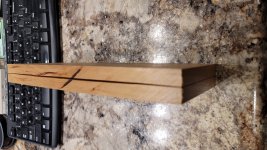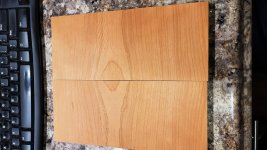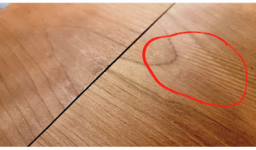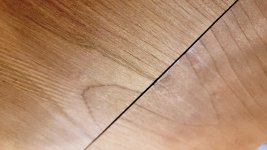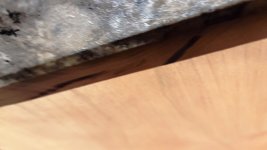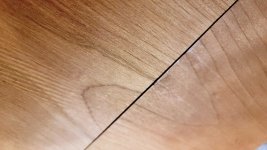I did make one cut with this 3/4" blade yesterday. As I said the cut quality was good. I would have liked to have had a little more material to start with but my board was 1-9/16" (1.5625) after planing. Deducting 25 thou for the blade leaves two pieces 0.76875. After running through the planer to yield two boards the same thickness I ended up at 11/16" or 0.6875, so 1/16" less than my desired final thickness of 3/4". So I only removed about 81 thou from each board to get the sawn face flat again. I thought that was pretty good. It just went slower than I expected at ~11 seconds per inch. The lost 1/16 won't hurt anything in the end. These two pieces are for the table top and they don't have to match the thickness of any other piece in the table. As long as the two halves of the top are the same thickness they will be fine. They get attached to each other with hinges and the top is removable from this portable sewing table I am building. That 'lost' 1/16 will only reduce the weight of the top slightly and have no affect on its performance or function.
As I was running the boards through the planer I noticed that the bandsaw cut was fairly flat across the 11 inch width of the board. And coming right off the bandsaw when I separated the two pieces there was no sawdust remaining between the halves, indicating to me that all the sawdust was carried out by the blade and nothing remained to cause the blade to bind or wander off course. I should have taken some photos of the cut coming off the saw but I didn't. I went back and looked at the video I shot while cutting but I had stopped the camera before I separated and inspected the cut so nothing to be learned there.
I have a bad habit of doing that, I don't know why. I could have let the video run but I always find myself wanting to turn it off as soon as I think its no longer needed like I'm wasting film. I guess I'm still thinking in terms of actual film and forgetting that my 128GB SD card in the GoPro has hours of capacity and trimming is easy in post on the PC.
Here's the last few seconds of the cut.
And some photos I took this morning of the test piece I ran. This is a piece of the same cherry but only about 4 inches high.
These pieces have not been touched by a plane or sander, this is how they looked coming right off the saw.
Shown as run through the saw
View attachment 1
Splayed out after the cut to show the cut faces of each half
View attachment 2
Some ripples where I hit a soft spot and the blade advanced too fast
View attachment 3
This is the planned outer face on the left and the sawn inner face on the right for comparison.
View attachment 4
